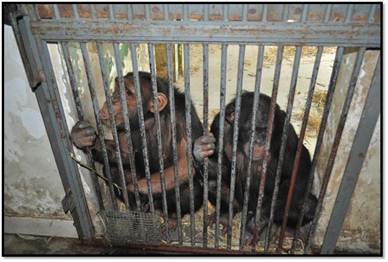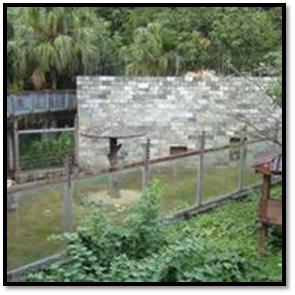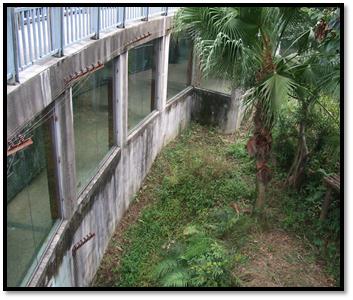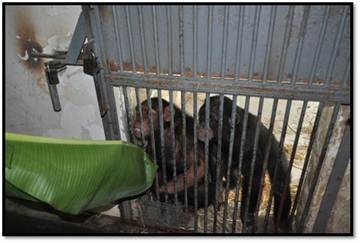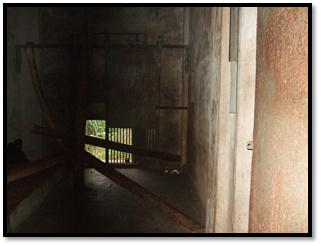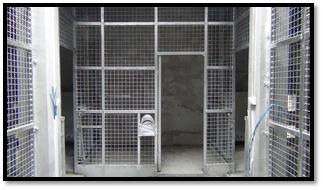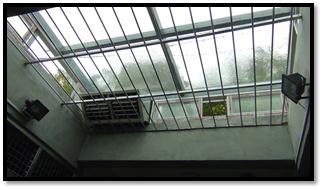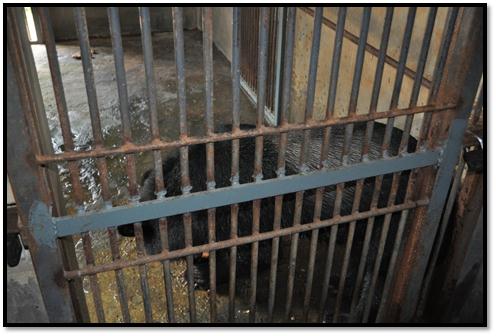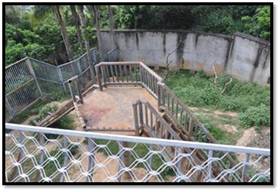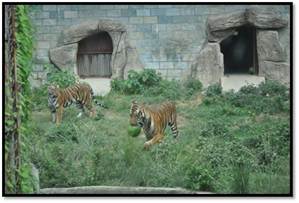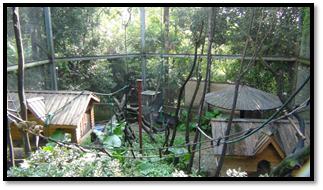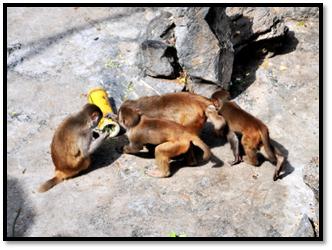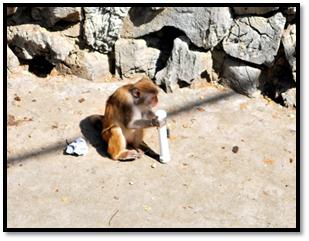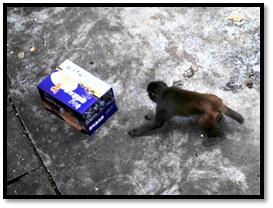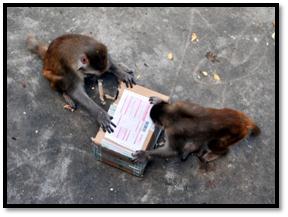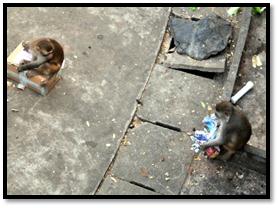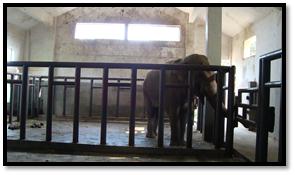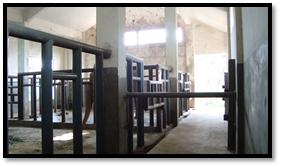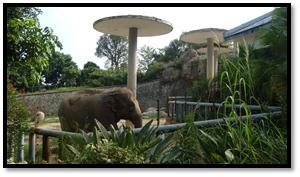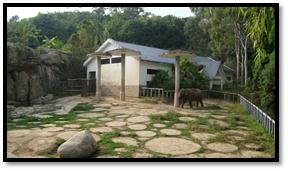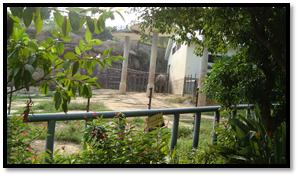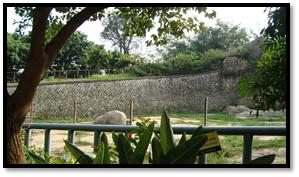
|
Hilda Tresz Global Volunteer Work | ||||||||||
| Argentina | Brazil | Chile | China | Egypt | India | Ivory Coast | Qatar | Russia | Senegal | United Arab Emirates |
|
China |
| Beijing Zoo | Changsha Zoo | Chengdu Zoo | Fuzhou Zoo | Guangzhou Zoo |
| Hangzhou Zoo | Jinan Zoo | Nanchang Zoo | Taiyuan Zoo |
|
Fuzhou Zoo |
Goals were to provide information regarding exhibit improvements, improve zoo wide animal training and educational workshops about husbandry and enrichment. Chimpanzees
(Pan troglodytes ?)
Subspecies unknown. Suggestions:
Subspecies needs to be determined by DNA testing.
BeiBei
F, 7 and Bowbow M, 6 Chimpanzee
exhibits The
chimpanzee exhibit was satisfactory in size, but needed
more climbing and sleeping structures as well as toys. The
night houses were large enough, made of concrete and
metal; lacked furniture and substrate and were very
dark. Straw, paper and browse were immediately added for
nest building and to take animals off of the unyielding
surface.
Suggestion: To further improve quality, some flexible furniture needs to be installed in each night quarters. Animals need both flexible and permanent structures in order to exhibit proper motor skills. All off exhibit areas should utilize three dimensions by adding large tree trunks, ropes, fire hoses, hammocks, wooden shelves, etc., to increase space and to the animals’ opportunities for exercise, exploration and manipulation. All cages are to be filled with substrate, browse, logs and branches. Since paper is readily available in China, all animals should receive newspapers, phone books, paper bags, etc,. in the night houses for nest building. It would be preferable if in the new night houses, there would be double sliding doors( one being solid and the other one built from bars and mesh). The night houses and exhibit should connect with a "Round Robin" system, when animals can be directed in circular ways and not just in linear. This system could be used for all species and would help with introductions or shift animals inside or outside easier and faster in one animal doesn't want to move. The
new night houses are being built as we
speak. They are very nice, spacious and light.
Follow
up
Chimpanzee
and Orangutan night house reconstruction will be
finished in a month or two. Heated
floor The
general assumption was the substrate cannot be provided
on heated floor due to being flammable. .
Suggestions:
All
animals can have substrate on heated floor. Another
option would be turning off the heat in one night house
and provide deep bedding for nest building while leaving
the heat on in the other and give the animals a choice.
Follow
up
Consultant
also confirmed with Dr. Steve Ross, SSP coordinator
regarding substrate use on heated floor. Exhibit
design
Follow up
The accreditation standards and related policies of Association
of Zoos and Aquariums, the Chimpanzee (Pan troglodytes)
Care Manual of Association of Zoos and Aquariums and the
South African National Standards were provided and is
being translated to Chinese in collaboration of the Jane
Goodall Institute and Animalsasia. General
propositions: Training
Consultant
was scheduled to walk around in each area and
give training advice regarding shifting, target and
scale training.
Follow
up
General
scale information and later elephant scale information
was provided via email.
Night
houses, off exhibit areas and correct substrate use Since
most animals lived in large, luxurious, green exhibits
and in proper social groups, our focus was mostly on
improving the “off exhibit” areas where animals were
isolated due to medical or husbandry reasons or locked
inside for longer periods of time for any temporary
housing reasons. Special attention needs to be paid to
all the night houses as well, where animals spend an
average 14-17 hours/day in concrete/bar cages.
Suggestions:
Continuing
to keep animals off of hard or cold, wet or dry,
unyielding surfaces (brick, concrete, etc.) would be
desirable. The use of appropriate substrate (inside-
paper products, hay or straw, etc.; outside-
nonflammable materials such as grass, sand, soil, mulch,
fresh browse, etc.) will make a significant difference
not only in the animals’ health but also in
improvement of the exhibit aesthetics. Furniture Some
exhibits had metal furniture.
Suggestions:
Metal
furniture should be changed to wooden ones. Metal is hot
in the summer and cold in the winter.
Orangutan
training Target
training program started by the consultant but had no
time to follow up because needed to leave to Changsha
Zoo. Although animal was turning around well, it would
not present his hind quarters for medical exams.
Follow
up
Shaping
plan was provided via email Browse
The
zoo has large amount of edible vegetation available on
grounds that could provide fresh, leafy branches
(browse).
Suggestions:
Browse
should be provided especially inside the night houses at
least every 2-3 days, but if possible, every day. As
mentioned during the presentation, the zoo can start
planting edible trees, bushes and even crops
inside and outside of exhibits, along visitor pathways
and resting areas that will provide future browsing
materials for growing collection demands. Whether cut by
staff or available by natural damage, fallen vegetation
can be used rather than wasted. Extending
foraging time All
animals need to be fed in a way that their foraging time
is extended and proper species-specific behaviors are
encouraged. If no one can be appointed for this
position, staff can be scheduled to cut browse and chop
diet on a rotation basis. Improving
enrichment programs Although
animals were kept in large exhibits, they were often
inactive. Simple, solutions of enrichment ideas as well
as the Phoenix Zoo’s monthly enrichment calendars were
provided.
Follow
up
The
work has been continuing even after I have left. Food
enrichment such as bamboo puzzle feeders, PVC feeders,
newspaper and cardboard feeders were given to primates.
Mr.
Liao, Deputy Husbandry Curator is working on sending
some keepers to visit and communicate with other zoos to
widen their knowledge. So far, the enrichment was only
welcomed by some technician people. The zoo will give
small amount of compensation to staff to encourage
providing enrichment. Elephant
program The
zoo currently has two elephants that are kept separated
due to serious food aggression. There is no enrichment
in their enclosure and night houses. There were previous
attempts for introductions but male was too aggressive.
A similar management program that Phoenix Zoo
implemented can be tried to decrease aggression and to
teach animals to forage longer. Contact information of
Phoenix Zoo’s Elephant Manager (Heather wright) was
given and communication has been started.
Follow
up:
Fuzhou
Zoo Management has provided enclosure information
already and the Phoenix Zoo’s Elephant Manager is
communicating with Management regarding the a new
enrichment program and a possible future introduction.
Education The
following Power Point presentations were given to all
staff: ·
Lack of substrate use in zoos addresses the easy
fix of empty cages and shows how much benefit there is
in the animals’ lives when provided with substrate;
i.e., when they do not have to sit inside of empty
concrete cages. This is probably the most important
animal welfare presentation to give out of the five. ·
Contra freeloading at the Phoenix Zoo
presentation talks about making animals work for their
food in similar ways as they would in the wild instead
of eating diet in short period of time from metal dishes
or rubber tubs. ·
The beneficial browse gives guidelines regarding
how to develop a zoo-wide browse program with numerous
browse gardens in the middle of the Sonoran Desert with
no money; it also addresses the major changes that
fresh, leafy greens can make in the animals’ lives. ·
Let them be elephants addresses the changes we
made in our elephants’ lives, how we helped their
behaviors by teaching them how to forage right and
behave like normal females; it also talks about basic
husbandry, enrichment ideas and health care. Presentations are available at htresz@thephxzoo.com I would like to thank the Fuzhou Zoos’ director and staffs as well as the Chinese Association of Zoological Gardens (CAZG) for their incredible hospitality, making me feel so welcomed. I
would also like to thank Animals Asia Foundation for
funding and organizing this trip and to establish such a
wonderful, working relationship between the Jane Goodall
Institute, the Phoenix Zoo and Fuzhou Zoo. |
| Program
Information |
| Research Research Papers Password
Required
|
|
Education Instruction Manuals ChimpanZoo Data System Guide
|
Contact Information
ChimpanZoo
the Jane Goodall Institute
| Global
BWB Secretarial Limited
10 Queen Street Place
London, EC4R 1BE
United Kingdom
